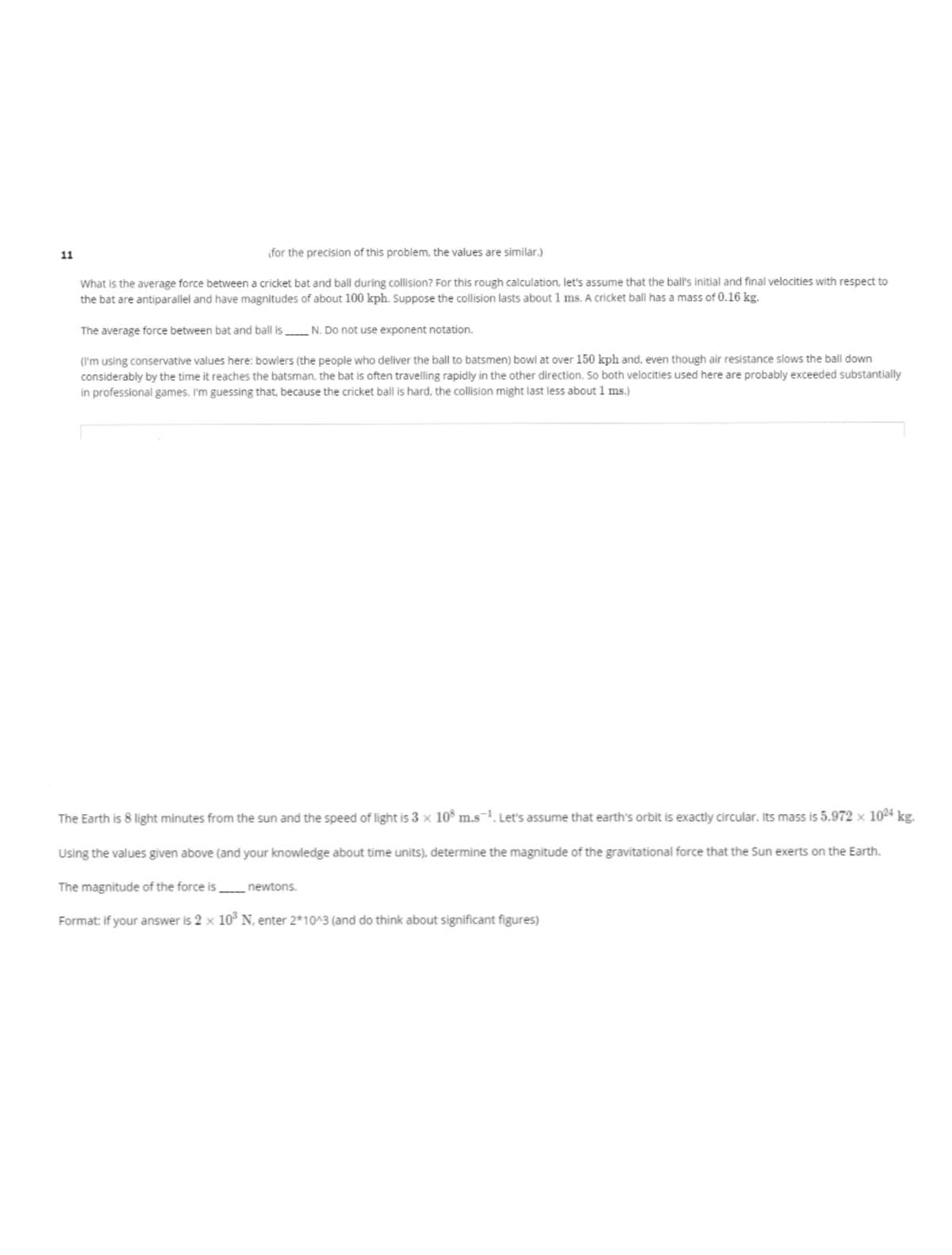College Physics
11th Edition
ISBN:9781305952300
Author:Raymond A. Serway, Chris Vuille
Publisher:Raymond A. Serway, Chris Vuille
Chapter6: Momentum, Impulse, And Collisions
Section: Chapter Questions
Problem 45P: A tennis ball of mass 57.0 g is held just above a basketball of mass 590 g. With their centers...
Related questions
Question
W4
11.13

Transcribed Image Text:11
for the precision of this problem, the values are similar.)
What is the average force between a cricket bat and ball during collision? For this rough calculation, let's assume that the ball's initial and final velocities with respect to
the bat are antiparallel and have magnitudes of about 100 kph. Suppose the collision lasts about 1 ms. A cricket ball has a mass of 0.16 kg.
The average force between bat and ball is
N. Do not use exponent notation.
(I'm using conservative values here: bowlers (the people who deliver the ball to batsmen) bowl at over 150 kph and, even though air resistance slows the ball down
considerably by the time it reaches the batsman, the bat is often travelling rapidly in the other direction. So both velocities used here are probably exceeded substantially
in professional games. I'm guessing that, because the cricket ball is hard, the collision might last less about 1 ms.)
The Earth is 8 light minutes from the sun and the speed of light is 3 x 10° m.s¯1. Let's assume that earth's orbit is exactly circular. Its mass is 5.972 x 1024 kg.
Using the values given above (and your knowledge about time units), determine the magnitude of the gravitational force that the Sun exerts on the Earth.
The magnitude of the force is newtons.
Format: if your answer is 2 x 10° N, enter 2*10^3 (and do think about significant figures)

Transcribed Image Text:How does the force that the Sun exerts on the Earth compare with the Earth's force on the sun?
O The magnitude of the force the earth exerts on the sun equals that of the force that the sun exerts on the earth.
O The magnitude of the force the earth exerts on the sun exceeds that of the force that the sun exerts on the earth.
The magnitude of the force the earth exerts on the sun is less than that of the force that the sun exerts on the earth.
Expert Solution
This question has been solved!
Explore an expertly crafted, step-by-step solution for a thorough understanding of key concepts.
This is a popular solution!
Trending now
This is a popular solution!
Step by step
Solved in 2 steps with 2 images

Knowledge Booster
Learn more about
Need a deep-dive on the concept behind this application? Look no further. Learn more about this topic, physics and related others by exploring similar questions and additional content below.Recommended textbooks for you

College Physics
Physics
ISBN:
9781305952300
Author:
Raymond A. Serway, Chris Vuille
Publisher:
Cengage Learning

University Physics Volume 1
Physics
ISBN:
9781938168277
Author:
William Moebs, Samuel J. Ling, Jeff Sanny
Publisher:
OpenStax - Rice University

Physics for Scientists and Engineers, Technology …
Physics
ISBN:
9781305116399
Author:
Raymond A. Serway, John W. Jewett
Publisher:
Cengage Learning

College Physics
Physics
ISBN:
9781305952300
Author:
Raymond A. Serway, Chris Vuille
Publisher:
Cengage Learning

University Physics Volume 1
Physics
ISBN:
9781938168277
Author:
William Moebs, Samuel J. Ling, Jeff Sanny
Publisher:
OpenStax - Rice University

Physics for Scientists and Engineers, Technology …
Physics
ISBN:
9781305116399
Author:
Raymond A. Serway, John W. Jewett
Publisher:
Cengage Learning

Principles of Physics: A Calculus-Based Text
Physics
ISBN:
9781133104261
Author:
Raymond A. Serway, John W. Jewett
Publisher:
Cengage Learning

College Physics
Physics
ISBN:
9781285737027
Author:
Raymond A. Serway, Chris Vuille
Publisher:
Cengage Learning

Glencoe Physics: Principles and Problems, Student…
Physics
ISBN:
9780078807213
Author:
Paul W. Zitzewitz
Publisher:
Glencoe/McGraw-Hill